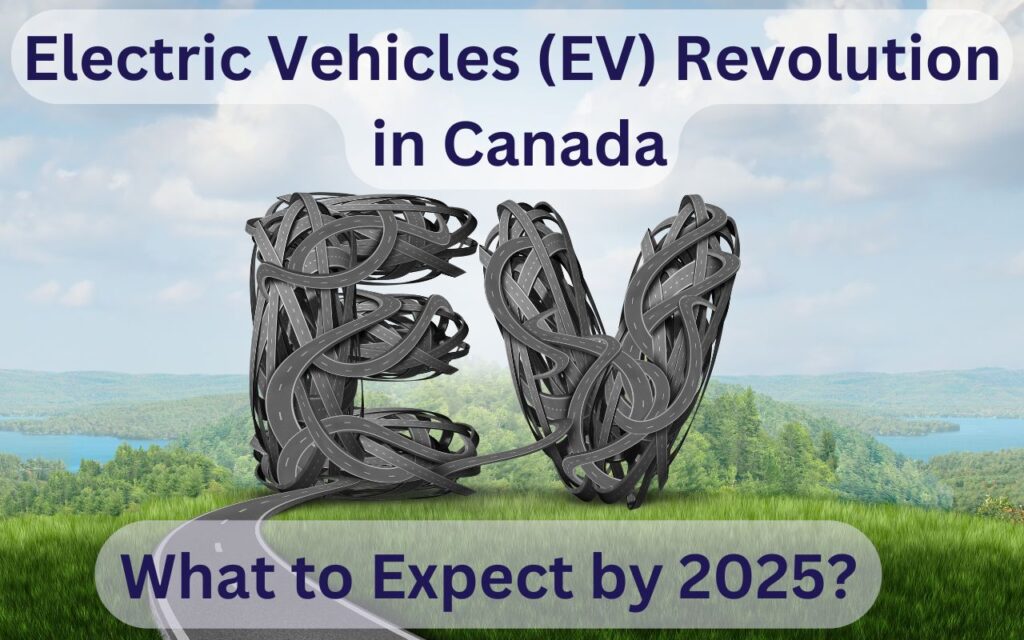Canada is playing at the forefront of the Electric Vehicles (EV) Revolution, both the Canadian government and auto industry pushing towards a greener future.The Canadian government wants to make electric vehicles more accessible for its citizens.
For this they are heavily investing in the EV industry such as more EV charging station, incentives for buyers. As the worldwide concern grows over environmental issues, a large number of Canadians are shifting towards the EV Vehicle, reducing the country’s carbon footprint.
Canada is in a huge shift towards efficient power energy. One of the primary drivers is the ascent of Electric Vehicles (EVs). By 2025, the back roads’ will look very changed as additional Canadians change from fuel-controlled vehicles to electric models. However, why is this event, and what’s the importance here for what’s to come?
Electric Vehicles Revolution in Canada
The federal government has defined aggressive objectives to decrease ozone-harming substance emissions. Canada intends to arrive at net-zero emissions by 2050, and changing to EVs is a vital piece of that arrangement.
| Title | Electric Vehicles (EV) Revolution in Canada |
| Department | Federal government |
| Country | Canada |
The nation is empowering the utilization of Electric Vehicles by offering motivating forces, subsidizing infrastructure, and fixing emissions principles. EVs are seen as a central stage toward diminishing defilement and engaging ecological change.

In 2021, the government proclaimed that all new vehicle arrangements ought to be zero-emission vehicles by 2035. This plan is significant for the greater push for cleaner energy and more legitimate transportation. By 2025, we can expect further fixing of rules and basic development in EV gathering.
What Elements Are Shaping Canada’s EV Revolution by 2025?
- In the first place, the cost of Electric Vehicles (EV) is dropping, making them more sensible for ordinary clients. Battery advancement has improved, and economies of scale have diminished collecting costs.
- Second, government forces, similar to discounts, are making EVs even really charming. Various locales, including Quebec and English Columbia, offer limits for EV purchases, further cutting down the cost for clients.
Extended Charging Infrastructure
One of the greatest moves of the Canadian government towards the Electric Vehicles (EV) Revolution is that the government is expanding their infrastructure in the EV industry by increasing the number of EV charging stations.
One of the greatest obstacles to EV reception has been the absence of charging infrastructure. However, Canada is endeavoring to address this test. The federal government, alongside commonplace governments and privately owned businesses, is putting vigorously in growing the charging organization.
By 2025, we hope to see a huge expansion in the number of public charging stations in the nation. Significant thruways will have quick charging stations, making extremely long travel more straightforward for electric vehicle proprietors.
Metropolitan people groups will in like manner have extra charging decisions, with stations being presented in parking structures, malls, and nearby areas.
The government’s Zero Emission Vehicle Infrastructure Program (ZEVIP) is having a fundamental impact on this development. The program is giving support to the foundation of charging stations, to have 20,000 new chargers open by 2025. Hence, charging an EV will become as supportive as fixing a gas tank.
Progresses in Battery Innovation
Battery advancement is at the center of the Electric Vehicle (EV) Revolution. By 2025, we can expect tremendous degrees of progress around here. Lithium-molecule batteries, which are at present the most notable sort used in EVs, are ending up being more capable and more affordable to make. This will help with reducing the cost of EVs and increasing their driving reach.
State-of-the-art batteries, as solid-state batteries, are also not excessively far off. These batteries might conceivably store more energy, charge speedier, and last longer than current lithium-molecule batteries.
By 2025, we might see the principal business EVs outfitted with strong state batteries, offering longer driving reaches and further developed execution.
Environmental Benefit of Electric Vehicles:- Helps in Reducing Country’s Carbon Footprint
One of the essential clarifications behind propelling EVs is their environmental impact. EVs produce zero tailpipe emissions, and that suggests they don’t convey pernicious toxins like carbon dioxide, nitrogen oxides, or particulate matter. This is especially huge in metropolitan networks, where air pollution is a basic prosperity concern.
As well as reducing air defilement, EVs can moreover help with diminishing ozone-hurting substance emissions, especially when constrained by a harm to the ecosystem power.
Canada’s electricity network is currently one of the cleanest on earth, with a tremendous piece of its energy coming from hydroelectric, wind, and sun-situated power. As the country continues to move towards maintainable power sources, the natural benefits of EVs will simply increase.
Job Creation by Canadian Automakers
Canada has serious areas of strength for an industry, and its part in the Electric Vehicles (EV) Revolution is developing. Several Canadian automakers are putting resources into electric vehicle creation, either by building their models or by providing parts to major worldwide makers.
General Motors (GM), which has areas of strength in Canada, has focused on delivering Electric Vehicles at its plant in Ingersoll, Ontario. The organization has declared plans to make electric conveyance vans, and by 2025, it hopes to extend its EV creation even further. Different automakers, like Portage and Stellantis, are additionally making critical interests in Canadian EV creation.
Government Policies For Net-Zero Emission by 2035
Notwithstanding monetary motivating forces, the government is putting resources into infrastructure, for example, charging stations and electric vehicle production, which is the great move toward the Electric Vehicles (EV) Revolution.
It is likewise acquainting guidelines with make it harder for automakers to sell fuel-controlled vehicles. By 2025, we can expect even more grounded government support as the nation pushes towards its net-zero emissions objective.
Difficulties with EV Reception
- While the eventual fate of Electric Vehicles in Canada looks splendid, there are still a few difficulties to survive. One of the greatest is the accessibility of reasonable EVs. Even though costs are dropping, numerous Electric Vehicles are even more costly than their fuel-controlled partners. For some Canadians, particularly those in provincial regions, the higher forthright expense of an EV is a boundary to reception.
- One more test is the accessibility of charging infrastructure in distant regions. While urban communities and significant parkways are seeing a fast development of charging stations, country regions are falling behind. This can make long travel in an electric vehicle challenging for individuals who live in or travel through these locales.
- At last, there is the issue of reaching tension. Despite the fact that EV ranges are improving, numerous shoppers are as yet worried about the capacity of an electric vehicle to travel significant distances on a solitary charge. This is particularly evident in cool environments, similar to Canada, where battery execution can be impacted by low temperatures.
What to Expect by 2025?
- The government’s level-headed 100% zero-emission vehicle bargains by 2035 are forceful, yet the country is making strides. By 2025, we can guess that EVs ought to make up the significantly greater part of new vehicle bargains.
- Second, charging infrastructure will keep on extending. More open charging stations will be accessible, making it simpler for Canadians to charge their vehicles. Extremely long travel in an EV will turn out to be more advantageous as quick charging stations are introduced along significant expressways.
- Third, progress in battery innovation will prompt longer driving reaches and more limited charging times. New advancements, for example, strong state batteries, will work on the exhibition and proficiency of EVs, making them more appealing to shoppers.
- At last, the Canadian car industry will assume a bigger part in the worldwide EV market. With automakers putting resources into EV creation and Canada’s rich stockpile of basic minerals, the nation is strategically set up to turn into a forerunner in the green economy.
Conclusion
Electric Vehicles are at the front of Canada’s Green Revolution. By 2025, we can expect gigantic changes in the country’s auto scene. More Canadians will be driving Electric Vehicles, charging infrastructure will be more broad, and the environmental benefits will be huge.
| Homepage | uhmychart.org |
The change to Electric Vehicles isn’t without its troubles, yet what the future holds looks wonderful as Canada moves towards a cleaner, more legitimate transportation system.
As the country continues to invest assets harmless to the ecosystem power effort and development, the Electric Vehicle (EV) Revolution will be an essential part in trimming Canada’s green future.
FAQs About EV Revolution in Canada
1. Why is Canada pushing for Electric Vehicles (EVs)?
Canada is promoting EVs to reduce greenhouse gas emissions and fight climate change as part of its net-zero emissions goal by 2050.
2. What government incentives are available for buying an EV in Canada?
The federal ZEV program offers rebates of up to $5,000, and some provinces provide additional rebates.
3. Will there be enough charging stations by 2025?
Yes, Canada is rapidly expanding its charging infrastructure, aiming for 20,000 new public chargers by 2025.
4. What advancements can we expect in EV technology by 2025?
Improvements in battery technology, such as solid-state batteries, will result in longer ranges and faster charging times.
5. How much of Canada’s new car sales will be electric by 2025?
EVs are expected to make up a significant portion of new vehicle sales, with a push towards 100% zero-emission vehicle sales by 2035.
PV Martinez holds an MBA in Finance from the University of Michigan. When not analyzing numbers, PV enjoys playing football and spending time singing his favorite tunes.





